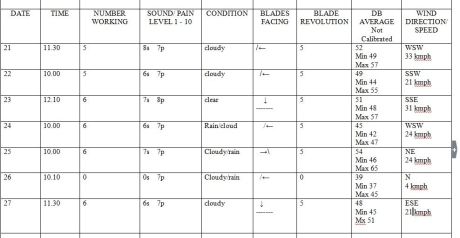Wind Energy Insurance Claims Massachusetts Devastating
The Town of Falmouth has made the decision to call its insurance company, Massachusetts Interlocal Insurance Association, to make a claim.

The Massachusetts municipal insurance sector has grown more comfortable with wind turbines as it has developed but has ignored claims by thousands of residents across Massachusetts who describe the noise from the turbines as torture from lack of sleep.
The number of underwriters providing coverage has gone from one or two firms to well over a dozen
Fact :
The Massachusetts Technology Collaborative today the Massachusetts Clean Energy Center, MassCEC has funded the majority of the deeply flawed wind turbine pre-construction studies used by developers to gain permit approval for commercial megawatt wind turbines. Almost all of the projects post construction have seriously understated the audible noise emissions and have completely ignored evaluating the low frequency and infra sound emissions.
Who:
The managers and engineers at the state agency have always been aware of the 1987 study done by the NASA investigation by Dr. Neil Kelley and his colleagues. The MassCEC also in 2005 warned of two distinct types of noise ,regulatory and human annoyance, but later dropped the warnings for the Falmouth installations in 2010. The agency today ignores what it called human annoyance in 2005
The MassCEC state agency produced studies around 2008 and forward full of omissions and lacked noise warnings.The agency painted a rosy picture. Today as many as twenty one communities were pushed down this same rosy path, again fully sponsored and funded by the Mass CEC. Most residents fell for it hook, line and sinker and many today still believe the snake oil they drank will work.
When:
In the spring of 2010, Falmouth’s first of two 1.65 MW wind turbines became operational. The adverse effects were immediate.The Consensus Building Institute, Falmouth Wind Turbine Option Analysis Process (WTOP) in 2012 described a toxic real estate zone of 200 residential homes around the turbines.
Today Six years later:
Up to 65 individual residents out of 45 households (including children) have stated that their health and well-being have been negatively affected by the operation of the turbines. (Sleep disturbance, headaches, increase in blood pressure, shortness of breath, tinnitus, vertigo, to mention some symptoms).
Two separate Zoning Board decisions declared that the turbines are a nuisance, ordering the owner of the turbines (Town of Falmouth) to “eliminate the nuisance”.
What:
The Town, as a result, has sued its own Zoning Board (twice);
A Barnstable Superior Court Judge has stated that there is “credible evidence of irreparable harm” and has ordered the turbines to cease operation during the night time 12 hours and not at all on Sunday
Massachusetts DEP noise violations have been recorded during night time testing (limited testing)
As a result of all of the turbine litigation, the Town of Falmouth has retained the services of multiple (Boston based) attorneys, to help Falmouth’s Town Counsel. (paid for by the MassCEC)
The litigation fees are near $300,000.00 every six months
Falmouth is ground zero for poorly placed wind turbines in the United States.
After a two year wind turbine moratorium, the Falmouth Planning Board wrote new turbine bylaws that restrict further turbines in town. These restrictive bylaws were adapted unanimously at Town Meeting.
Recent real estate values have identified a “stagnant market” in the proximity of the turbines, with several appraisals reflecting a 20% decrease in value due to the presence of the turbines.
A privately funded sound study was recently performed near a home which identified a low frequency, high amplitude modulated sound signature that was 100% attributable to the wind turbines.
“Acoustical trespass” is the term used for this in the acoustics field.
During a mediation hearing for a Federal Court case regarding nuisance, an initial offer of $5,000 each was withdrawn by insurance company attorneys who cited “there are too many municipalities in the Commonwealth with wind turbine problems, and we cannot establish precedent with any amount of payout”.
MassCEC has funded a consensus process that attempted to resolve the turbine situation in Falmouth. After several months and many hours of volunteer work by residents, and close to $139,000.00 of rate payers money paid to The Consensus Building Institute, it was determined that the low frequency noise cannot be mitigated by insulation or special windows or planting trees, that the only mitigation for those adversely affected by the turbines that will work is either separation from the turbines or total curtailment of the turbines.
Responsibility :
Two weeks ago , Board of Selectmen Chairman Doug Jones announced the Select Board had voted in executive session to authorize the town’s insurer, Massachusetts Interlocal Insurance Association ,to start mediation with all the parties in as many as eleven pending litigations to resolve outstanding legal actions.
The claims include zoning violations, emotional distress, nuisance and property devaluation.
There is more than enough evidence to show the Massachusetts Clean Energy Center followed a commercial wind turbine renewable energy agenda and ignored the health and safety of the general public affecting thousands of Massachusetts residents. As a matter of fact the Town of Falmouth and everyone including the Massachusetts Clean Energy Center was a aware of the hidden August 2010 Vestas wind turbine noise warning and kept the letter secret for 5 years.
The Massachusetts Interlocal Insurance Association will be tasked with resolving years of mitigation and eleven lawsuits in Falmouth.
The Massachusetts Interlocal Insurance Association (MIIA) was incorporated by the Massachusetts Municipal Association in 1982 as a nonprofit organization to provide insurance services to the cities, towns.
The Massachusetts Interlocal Insurance Association functions as the administrator for the MIIA Property and Casualty Group Inc.
The MIIA Property and Casualty Group Inc., formed in 1987, provides property and casualty coverage for cities, towns
The Town of Falmouth has made the decision to call its insurance company to make a claim.
Massachusetts has at least twenty one other communities with poorly placed wind turbines.
The insurance carrier will certainly pay all the claims but be assured all the cities and towns in Massachusetts will be assessed major premium increases as the claims roll in.


















